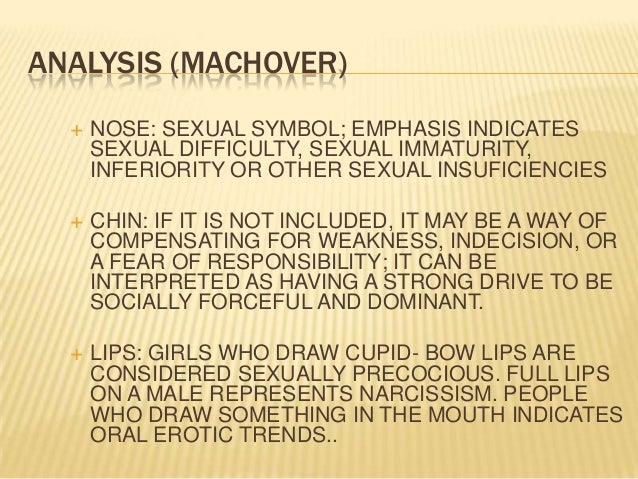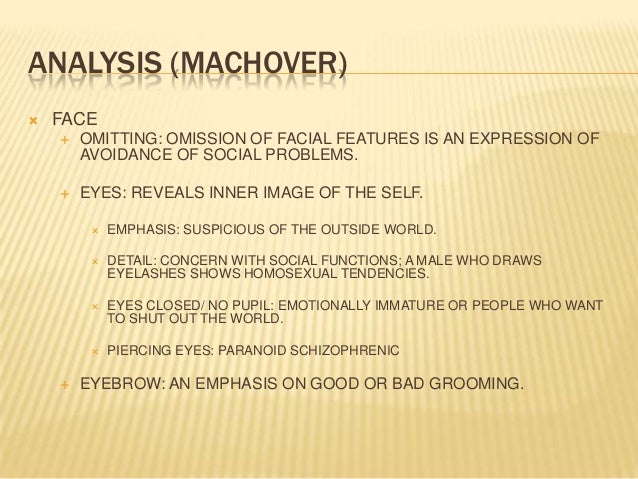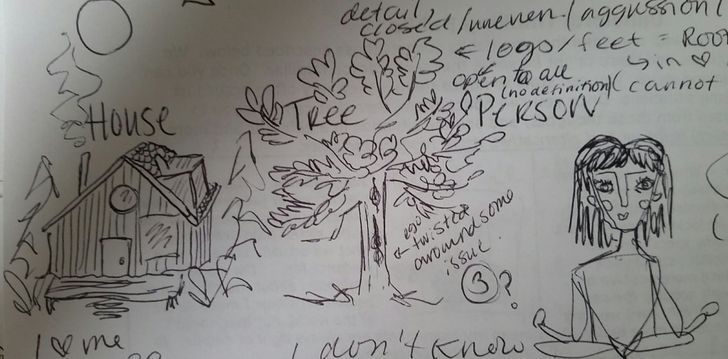Definition
The House-Tree-Person Test Carolyn R. Background HTP: Draw a house, tree, person, & opposite sex person. Inner view of himself/herself the environment the things considered important Administration Pencil & white paper. Patient asked to draw a good house (as good as possible), take as much time as needed, erase anything you need to. GOODENOUGH DRAW – A – PERSON TEST DIRECTIONS: “I want you to make a picture of a person. Make the very best picture that you can. Take your time and work very carefully. Try very hard and see what a good picture you can make.” TIME: No time limit. Usually 10 minutes will suffice with young children.

Figure drawings are projective diagnostic techniques in which an individual is instructed to draw a person, an object, or a situation so that cognitive, interpersonal, or psychological functioning can be assessed.
Purpose
A projective test is one in which a test taker responds to or provides ambiguous, abstract, or unstructured stimuli, often in the form of pictures or drawings. While other projective tests, such as the Rorschach Technique and Thematic Apperception Test , ask the test taker to interpret existing pictures, figure drawing tests require the test taker to create the pictures themselves. In most cases, figure drawing tests are given to children. This is because it is a simple, manageable task that children can relate to and enjoy.
Some figure drawing tests are primarily measures of cognitive abilities or cognitive development. In these tests, there is a consideration of how well a child draws and the content of a child's drawing. In some tests, the child's self-image is considered through the use of the drawings. In other figure drawing tests, interpersonal relationships are assessed by having the child draw a family or some other situation in which more than one person is present. Some tests are used for the evaluation of child abuse . Other tests involve personality interpretation through drawings of objects, such as a tree or a house, as well as people. Finally, some figure drawing tests are used as part of the diagnostic procedure for specific types of psychological or neuropsychological impairment, such as central nervous system dysfunction or mental retardation .
Precautions
Despite the flexibility in administration and interpretation of figure drawings, these tests require skilled and trained administrators familiar with both the theory behind the tests and the structure of the tests themselves. Interpretations should be made with caution and the limitations of projective tests should be considered. It is generally a good idea to use projective tests as part of an overall test battery. There is little professional support for the use of figure drawing, so the examples that follow should be interpreted with caution.
Description
The Draw-A-Man Test, developed by Goodenough in 1926 was the first formal figure drawing test. It was used to estimate a child's cognitive and intellectual abilities reflected in the drawing's quality. The test was later revised by Harris in 1963 as the Goodenough Harris Drawing Test (GHDT), which included a detailed scoring system and allowed for drawings of men, women, and the self. The scoring system primarily reflected the way in which the child is maturing cognitively. The GHTD is appropriate for children between the ages of three and 17, although it has been found to be most useful for children between three and 10.
The Draw-A-Person test (DAP) was developed by Machover in 1948 and used figure drawings in a more projective way, focusing on how the drawings reflected the anxieties, impulses, self-esteem, and personality of the test taker. In this test, children are first asked to draw a picture of a person. Then, they are asked to draw a picture of a person of the sex opposite of the first drawing. Sometimes, children are also asked to draw a picture of the self and/or family members. Then, they are asked a series of questions about themselves and the drawings. These questions can be about the mood, the ambitions, and the good and bad qualities of the people in the drawings. The pictures and the questions on the DAP are meant to elicit information about the child's anxieties, impulses, and overall personality. The DAP is the most frequently used figure drawing test today. A scoring system appropriate for adults was developed in 1993 by Mitchel, Trent, and McArthur.
In 1992, Naglieri and his colleagues created a more specific scoring system for figure drawing tests called the Draw-A-Person: Screening Procedure of Emotional Disturbance (DAP:SPED), based on a large standardization sample. This scoring method includes 55 items rated by the test administrator and based on the child's drawings and responses to questions. The DAP:SPED is appropriate for children aged six to 17. It is often used as a screening method for children who may be having difficulties with regard to social adjustment and require further evaluation.
The House-Tree-Person (HTP) test , created by Buck in 1948, provides a measure of a self-perception and attitudes by requiring the test taker to draw a house, a tree, and a person. The picture of the house is supposed to conjure the child's feelings toward his or her family. The picture of the tree is supposed to elicit feelings of strength or weakness. The picture of the person, as with other figure drawing tests, elicits information regarding the child's self-concept. The HTP, though mostly given to children and adolescents, is appropriate for anyone over the age of three.
The Kinetic Family Drawing technique (KFD), developed in 1970 by Burns and Kaufman, requires the test taker to draw a picture of his or her entire family. Children are asked to draw a picture of their family, including themselves, 'doing something.' This picture is meant to elicit the child's attitudes toward his or her family and the overall family dynamics. The KFD is some times interpreted as part of an evaluation of child abuse. The Kinetic School Drawing technique (KSD), developed in 1974 by Prout and Phillips, requires the child to draw a picture of himself or herself, a teacher, and one or more classmates. This picture is meant to elic it the child's attitudes toward people at school and his or her functioning in the school environment.
Results

As with all projective measures, scoring on figure drawing tests is more subjective. Specific scoring systems, such as the DAP:SPED can be used to provide more objective information. Most figure drawing tests have some sort of objective scoring system; however, the instructions given to the child, the questions asked by the test administrator, and the administrator's interpretations of the drawings are flexible and this makes it difficult to compare results between children, even on the same measure. Also, many clinicians choose not to rely on the scoring systems and rely entirely on their own intuitive judgments regarding their interpretation of picture content.
Figure drawings are often interpreted with regard to appropriate cognitive development. Naglieri's DAP:SPED scoring system includes a consideration of what features in a drawing are appropriate for children of various ages. For example, five-year old children are expected to make fairly basic drawings of people, consisting of a head, eyes, nose, mouth, body, arms, and legs. An 11-year-old, on the other hand is expected to have more details in the picture, such as a more defined neck, clothes, and arms in a particular direction.
Sometimes, figure drawings are assessed with regard to self-image. Children often project themselves in the drawings. For example, females with body image concerns may reflect these concerns in their drawings. Victims of sexual abuse may stress sexual characteristics in their drawings.
Psychological, neuropsychological, or emotional dysfunction can also be considered in figure drawing interpretation. This type of interpretation is often done with figure drawings made by adults. For example, a person who omits or distorts body parts may suffer from emotional impairment. Excessive detail with regard to the sexual nature of the drawing may indicate sexual maladjustment.
Family dynamics are also interpreted through figure drawings. For example, in the Kinetic Family Drawing test, a picture where family members are in separate rooms may indicate isolation or a lack of interaction between family members.
Figure drawings are also interpreted with regard to child abuse. In 1994, Von Hutton developed a scoring system for both the HTP and DAP focusing on indicators of child abuse that may be present in drawings. The drawing of the family in the KFD test may also provide indicators of abuse.
There has been much debate over the overall reliability and validity of figure drawing tests (and projective tests in general). For example, when structured scoring systems are used, the DAP has been found to be a reliable measure, especially for cognitive development in children. However, with regard to specific personality characteristics, self-image issues, or personality dysfunctions, there has been relatively little support for the use of figure drawings.
BOOKS
Groth-Marnat, Gary. Handbook of Psychological Assessment 3rd edition. New York: John Wiley and Sons, 1997.

Kline, Paul. The Handbook of Psychological Testing. New York: Routledge, 1999.
Reynolds, Cecil R. Comprehensive Clinical Psychology, Volume 4: Assessment. Amsterdam: Elsevier, 1998.
Follow City-Data.com Founder
on our Forum or Twitter
Assessment | Biopsychology | Comparative |Cognitive | Developmental | Language | Individual differences |Personality | Philosophy | Social |
Methods | Statistics |Clinical | Educational | Industrial |Professional items |World psychology |
Social Processes:Methodology · Types of test
Please help recruit one, or improve this page yourself if you are qualified.
This banner appears on articles that are weak and whose contents should be approached with academic caution
.
The Goodenough-Harris Draw-A-Man Test or Draw-A-Man Test(DAP, DAP test0 is a psychological projectivepersonality or cognitive test used to evaluate children and adolescents for a variety of purposes.
History[edit | edit source]
Developed originally by Florence Goodenough in 1926, this test was first known as the Goodenough Draw-A-Man test. It is detailed in her book titled Measurement of Intelligence by Drawings. Dr. Dale B. Harris later revised and extended the test and it is now known as the Goodenough-Harris Drawing Test. The revision and extension is detailed in his book Children's Drawings as Measures of Intellectual Maturity (1963). Julian Jaynes, in his 1976 book The Origin of Consciousness in the Breakdown of the Bicameral Mind, wrote that the test is 'routinely administered as an indicator of schizophrenia,' and that while not all schizophrenic patients have trouble drawing a person, when they do, it is very clear evidence of a disorder. Specific signs could include a patient's neglect to include 'obvious anatomical parts like hands and eyes,' with 'blurred and unconnected lines,' ambiguous sexuality and general distortion.[1] There has been no validation of this test as indicative of schizophrenia. Chapman and Chapman (1969), in a classic study of illusory correlation, showed that the scoring manual, e.g., large eyes as indicative of paranoia, could be generated from the naive beliefs of undergraduates.
Nature of the test[edit | edit source]
Test administration involves the administrator requesting children to complete three individual drawings on separate pieces of paper. Children are asked to draw a man, a woman, and themselves. No further instructions are given and the child is free to make the drawing in whichever way he/she would like. There is no right or wrong type of drawing, although the child must make a drawing of a whole person each time - i.e. head to feet, not just the face. The test has no time limit, however, children rarely take longer than about 10 or 15 minutes to complete all three drawings. Harris's book (1963) provides scoring scales which are used to examine and score the child's drawings. The test is completely non-invasive and non-threatening to children - which is part of its appeal.
The purpose of the test is to assist professionals in inferring children's cognitive developmental levels with little or no influence of other factors such as language barriers or special needs. Any other uses of the test are merely projective and are not endorsed by the first creator.
See also[edit | edit source]
- House Tree Person Test (HTP)

References[edit | edit source]
- ↑Julian Jaynes, J. (2000), The Origin of Consciousness in the Breakdown of the Bicameral Mind, Mariner Books, ISBN 978-0-618-05707-8
- Chapman, L. J., & Chapman, J. P. (1969). Illusory correlation as an obstacle to the use of valid psychodiagnostic signs. Journal of Abnormal Psychology, 74, 271-280.
- Goodenough, F. (1926). Measurement of intelligence by drawings. New York: World Book Co.
- Harris, D. B. (1963). Children's drawings as measures of intellectual maturity. New York: Harcourt, Brace & World, Inc.
- Ter Laack, J.; de Goede, M.; Aleva, A.. 'The Draw-A-Person Test: An Indicator of Children's Cognitive and Socioemotional Adaptation?'. Heldref Publications.
- Williams, Simon D.; Wiener, Judy; MacMillan, Harriet. 'Build-A-Person Technique: An examination of the validity of human-figure features as evidence of child sexual abuse.'. Elsevier Science.
Draw A Person Assessment
Draw A Person Test Manual
| This page uses Creative Commons Licensed content from Wikipedia (view authors). |
